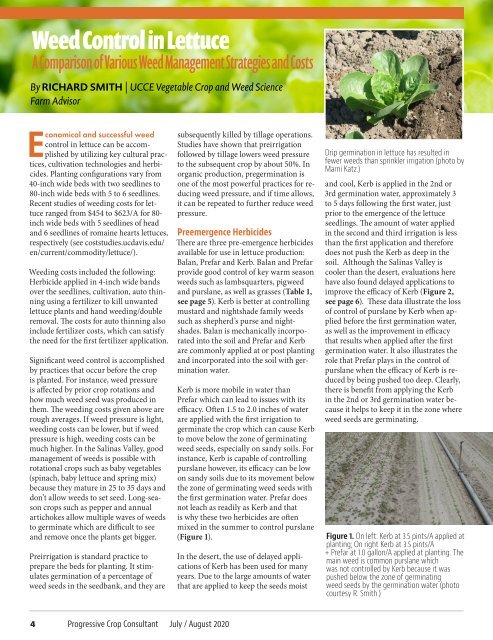Create successful ePaper yourself
Turn your PDF publications into a flip-book with our unique Google optimized e-Paper software.
Weed Control in Lettuce<br />
A Comparison of Various Weed Management Strategies and Costs<br />
By RICHARD SMITH | UCCE Vegetable Crop and Weed Science<br />
Farm Advisor<br />
Economical and successful weed<br />
control in lettuce can be accomplished<br />
by utilizing key cultural practices,<br />
cultivation technologies and herbicides.<br />
Planting configurations vary from<br />
40-inch wide beds with two seedlines to<br />
80-inch wide beds with 5 to 6 seedlines.<br />
Recent studies of weeding costs for lettuce<br />
ranged from $454 to $623/A for 80-<br />
inch wide beds with 5 seedlines of head<br />
and 6 seedlines of romaine hearts lettuces,<br />
respectively (see coststudies.ucdavis.edu/<br />
en/current/commodity/lettuce/).<br />
Weeding costs included the following:<br />
Herbicide applied in 4-inch wide bands<br />
over the seedlines, cultivation, auto thinning<br />
using a fertilizer to kill unwanted<br />
lettuce plants and hand weeding/double<br />
removal. The costs for auto thinning also<br />
include fertilizer costs, which can satisfy<br />
the need for the first fertilizer application.<br />
Significant weed control is accomplished<br />
by practices that occur before the crop<br />
is planted. For instance, weed pressure<br />
is affected by prior crop rotations and<br />
how much weed seed was produced in<br />
them. The weeding costs given above are<br />
rough averages. If weed pressure is light,<br />
weeding costs can be lower, but if weed<br />
pressure is high, weeding costs can be<br />
much higher. In the Salinas Valley, good<br />
management of weeds is possible with<br />
rotational crops such as baby vegetables<br />
(spinach, baby lettuce and spring mix)<br />
because they mature in 25 to 35 days and<br />
don’t allow weeds to set seed. Long-season<br />
crops such as pepper and annual<br />
artichokes allow multiple waves of weeds<br />
to germinate which are difficult to see<br />
and remove once the plants get bigger.<br />
Preirrigation is standard practice to<br />
prepare the beds for planting. It stimulates<br />
germination of a percentage of<br />
weed seeds in the seedbank, and they are<br />
subsequently killed by tillage operations.<br />
Studies have shown that preirrigation<br />
followed by tillage lowers weed pressure<br />
to the subsequent crop by about 50%. In<br />
organic production, pregermination is<br />
one of the most powerful practices for reducing<br />
weed pressure, and if time allows,<br />
it can be repeated to further reduce weed<br />
pressure.<br />
Preemergence Herbicides<br />
There are three pre-emergence herbicides<br />
available for use in lettuce production:<br />
Balan, Prefar and Kerb. Balan and Prefar<br />
provide good control of key warm season<br />
weeds such as lambsquarters, pigweed<br />
and purslane, as well as grasses (Table 1,<br />
see page 5). Kerb is better at controlling<br />
mustard and nightshade family weeds<br />
such as shepherd’s purse and nightshades.<br />
Balan is mechanically incorporated<br />
into the soil and Prefar and Kerb<br />
are commonly applied at or post planting<br />
and incorporated into the soil with germination<br />
water.<br />
Kerb is more mobile in water than<br />
Prefar which can lead to issues with its<br />
efficacy. Often 1.5 to 2.0 inches of water<br />
are applied with the first irrigation to<br />
germinate the crop which can cause Kerb<br />
to move below the zone of germinating<br />
weed seeds, especially on sandy soils. For<br />
instance, Kerb is capable of controlling<br />
purslane however, its efficacy can be low<br />
on sandy soils due to its movement below<br />
the zone of germinating weed seeds with<br />
the first germination water. Prefar does<br />
not leach as readily as Kerb and that<br />
is why these two herbicides are often<br />
mixed in the summer to control purslane<br />
(Figure 1).<br />
In the desert, the use of delayed applications<br />
of Kerb has been used for many<br />
years. Due to the large amounts of water<br />
that are applied to keep the seeds moist<br />
Drip germination in lettuce has resulted in<br />
fewer weeds than sprinkler irrigation (photo by<br />
Marni Katz.)<br />
and cool, Kerb is applied in the 2nd or<br />
3rd germination water, approximately 3<br />
to 5 days following the first water, just<br />
prior to the emergence of the lettuce<br />
seedlings. The amount of water applied<br />
in the second and third irrigation is less<br />
than the first application and therefore<br />
does not push the Kerb as deep in the<br />
soil. Although the Salinas Valley is<br />
cooler than the desert, evaluations here<br />
have also found delayed applications to<br />
improve the efficacy of Kerb (Figure 2,<br />
see page 6). These data illustrate the loss<br />
of control of purslane by Kerb when applied<br />
before the first germination water,<br />
as well as the improvement in efficacy<br />
that results when applied after the first<br />
germination water. It also illustrates the<br />
role that Prefar plays in the control of<br />
purslane when the efficacy of Kerb is reduced<br />
by being pushed too deep. Clearly,<br />
there is benefit from applying the Kerb<br />
in the 2nd or 3rd germination water because<br />
it helps to keep it in the zone where<br />
weed seeds are germinating.<br />
Figure 1. On left: Kerb at 3.5 pints/A applied at<br />
planting; On right Kerb at 3.5 pints/A<br />
+ Prefar at 1.0 gallon/A applied at planting. The<br />
main weed is common purslane which<br />
was not controlled by Kerb because it was<br />
pushed below the zone of germinating<br />
weed seeds by the germination water (photo<br />
courtesy R. Smith.)<br />
4 Progressive Crop Consultant <strong>July</strong> / <strong>August</strong> <strong>2020</strong>


















